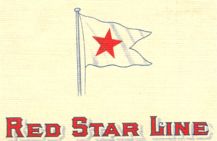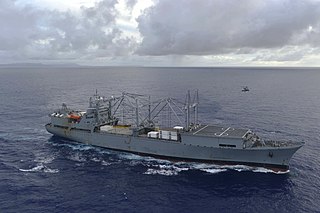
SS Nomadic is a former tender of the White Star Line, launched on 25 April 1911 in Belfast now on display in Belfast's Titanic Quarter. She was built to transfer passengers and mail to and from RMS Olympic and RMS Titanic, and is the only surviving White Star Line vessel in existence today.

The Pacific Mail Steamship Company was founded April 18, 1848, as a joint stock company under the laws of the State of New York by a group of New York City merchants. Incorporators included William H. Aspinwall, Edwin Bartlett, Henry Chauncey, Mr. Alsop, G.G. Howland and S.S. Howland.

The Red Star Line was a shipping line founded in 1871 as a joint venture between the International Navigation Company of Philadelphia, which also ran the American Line, and the Société Anonyme de Navigation Belgo-Américaine of Antwerp, Belgium. The company's main ports of call were Antwerp in Belgium, Liverpool and Southampton in the United Kingdom and New York City and Philadelphia in the United States.

The F-class submarines were a group of four submarines designed for the United States Navy by Electric Boat in 1909. F-1 and F-2 were built by Union Iron Works in San Francisco, while F-3 and F-4 were built by Moran Bros. in Seattle, Washington.

The C-class submarines were five United States Navy submarines built by the Fore River Shipbuilding Company in Quincy, Massachusetts, under a subcontract from the Electric Boat Company. Built between 1906 and 1909, and in commission from 1908 to 1919, all five were subsequently sold for scrap in 1920. They were considerably larger than the preceding B class at 275 tons submerged vs. 173 tons submerged, and were the first United States submarines with two-shaft propulsion, doubling the machinery of the B class.

The United States H-class submarines were Holland 602 type submarines used by the United States Navy.

The K-class submarines were a class of eight submarines of the United States Navy, serving between 1914 and 1923, including World War I. They were designed by Electric Boat and were built by other yards under subcontracts. K-1, K-2, K-5, and K-6 were built by Fore River Shipyard in Quincy, Massachusetts, K-3, K-7, and K-8 by Union Iron Works in San Francisco, and K-4 by Seattle Construction and Drydock Company in Seattle, Washington. All were decommissioned in 1923 and scrapped in 1931 to comply with the limits of the London Naval Treaty.

RMS Empress of China was an ocean liner built in 1890-1891 by Naval Construction & Armament Co., Barrow, England for Canadian Pacific Steamships (CP). This ship—the first of three CP vessels to be named Empress of China—regularly traversed the trans-Pacific route between the west coast of Canada and the Far East until she struck an underwater reef and sank in Tokyo harbour in 1911.

RMS Empress of India was an ocean liner built in 1890-1891 by Naval Construction & Armaments Co, Barrow-in-Furness, England for Canadian Pacific Steamships. This ship would be the first of two CP vessels to be named Empress of India, and on 28 April 1891, she was the very first of many ships named Empress arriving at Vancouver harbor.

SS Prinz Friedrich Wilhelm was an ocean liner for North German Lloyd (NDL) from her launch in 1907 until the end of World War I. After the war, she briefly served as USS Prinz Friedrich Wilhelm (ID-4063) for the United States Navy returning American troops from France. The vessel was first chartered—and later purchased outright—by Canadian Pacific Steamships (CP) and operated under the names Empress of China, Empress of India, Montlaurier, Monteith, and Montnairn. She was scrapped in 1929.

The Type C4-class ship were the largest cargo ships built by the United States Maritime Commission (MARCOM) during World War II. The design was originally developed for the American-Hawaiian Lines in 1941, but in late 1941 the plans were taken over by the MARCOM.
Cameronia was the name of a number of ships:
SS Statendam was a 10,322 ton (gross) ship of the Holland America Line, built by Harland and Wolff, launched in 1898 and completed on 18 August 1898. She was sold to the Allan Line in 1911 and renamed SS Scotian. The Allan Line was taken over in 1917 by Canadian Pacific Line, who continued to operate her as the Scotian until 1922, when she was renamed SS Marglen. She was scrapped in 1927.
SS Pontic was a tender and baggage vessel of the White Star Line that was built in 1894 by Harland & Wolff Ltd, Belfast, United Kingdom. She was sold in 1919 and continued in that role. In 1925, she was sold and used as a collier. She was scrapped in 1930.

SS Gothic was an ocean liner, built in 1893 at the Harland and Wolff Shipyards for the White Star Line. She was 490 ft long and 53 ft wide and 7755 gross registered tons. For much of her career she was transferred back and forth between White Star and the Red Star Line, both of which were subsidiaries of the International Mercantile Marine.
SS Santa Rosa may refer to:
SS Alt was a freight vessel built for the Lancashire and Yorkshire Railway in 1911.

The Type C5 ship is a United States Maritime Administration (MARAD) designation for World War II breakbulk cargo and later a container ship for containerization shipments. The first type C5-class ship was a class of ships constructed and produced in the United States during World War II. The World War II C5-class ship was dry bulk cargo ship built by Bethlehem Steel in Sparrows Point, Maryland. Bethlehem Steel built eight ships in this bulk cargo class and four orders were canceled. The C5-class ship has a 24,250 DWT and was 560 feet (170 m) long. The C5 was mainly used as iron ore carriers. The C5 was needed to replace other ships that sank during World War II. First in her class was SS Venore, USMC #1982, delivered on 20 July 1945. The Type C5-class ship designed to fill the need to move iron ore from Santa Cruz, Chile, to Sparrows Point, Maryland, through the Panama Canal, a round-trip of 8,700 nautical miles . Post World War II, four ships were given C5 class type C5-S-78a, these were roll-on/roll-off container ship built by Ingalls Shipbuilding, Inc. of Pascagoula, Mississippi and operated by the Moore-McCormack Lines. The C5-S-78a had a deadweight tonnage of 16,000 tons.

The Type R ship is a United States Maritime Administration (MARAD) designation for World War II refrigerated cargo ship, also called a reefer ship. The R type ship was used in World War II, Korean War, Vietnam War and the Cold War. Type R ships were used to transport perishable commodities which require temperature-controlled transportation, such as fruit, meat, fish, vegetables, dairy products and other foods. The US Maritime Commission ordered 41 new refrigerated ships for the US Navy. Because of the difficulty of building refrigerated ships only two were delivered in 1944, and just 26 were delivered in 1945 and the remainder in 1946–48. The 41 R type ships were built in four groups. Two of design types were modified type C1 ships and two were modified type C2 ships. The United Fruit Company operated many of the R type ships in World War II. The type R2-S-BV1 became the US Navy Alstede-class stores ship and the type R1-M-AV3 became the US Navy Adria-class stores ship.

SS Demosthenes was a UK steam ocean liner and refrigerated cargo ship. She was launched in 1911 in Ireland for Aberdeen Line and scrapped in 1931 in England. In the First World War she was an Allied troop ship.














